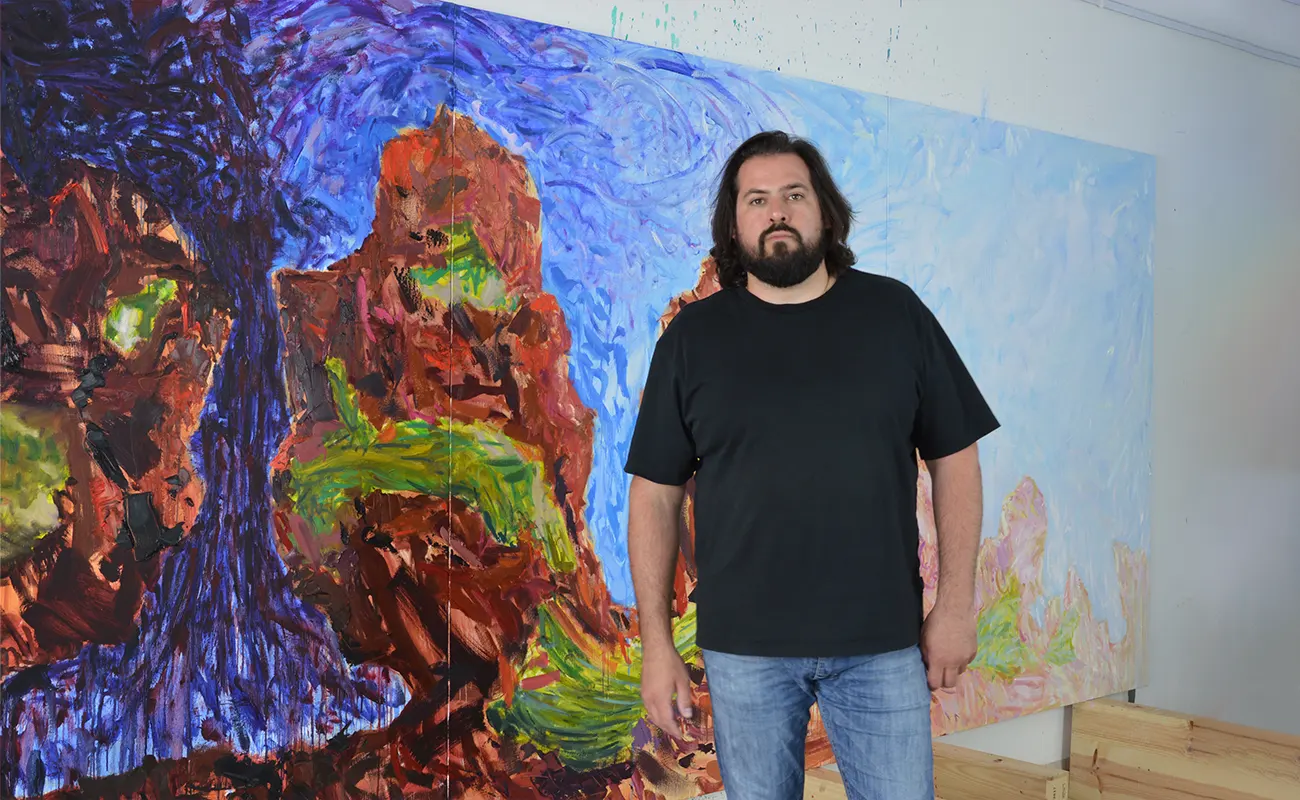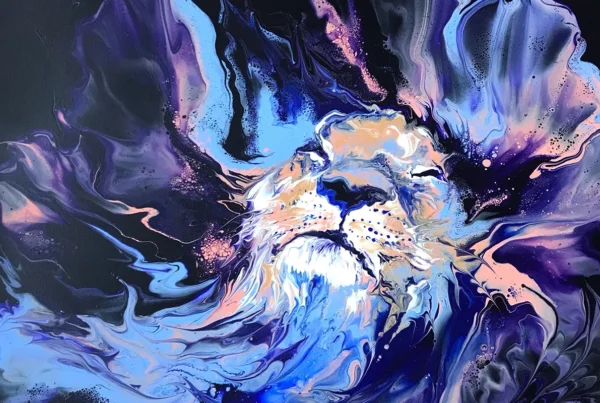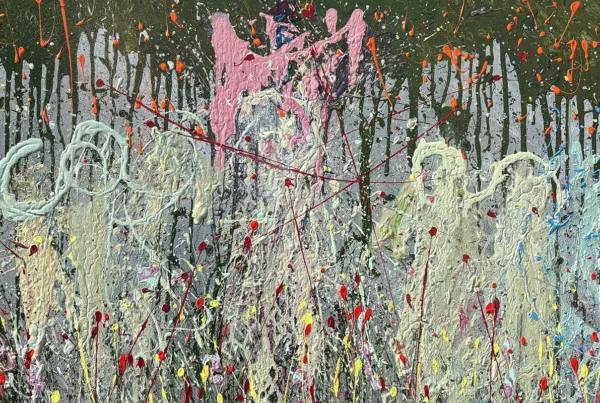“I remember what kind of great freedom I felt during its creation, and I see this as my basic natural painting style.”
Harmonizing Heritage and Creativity
Robert van de Graaf, a Dutch contemporary painter, crafts his art in The Hague, Netherlands, bringing a rich tapestry of Dutch, English, German, and Indonesian influences into his work. His lineage, a blend of cultural and professional diversity—from a grandmother who was a professional pianist to grandfathers who were a factory director with Indonesian heritage and a Dutch Major in the Navy—imbues his art with a profound depth and diversity. This eclectic background not only enriches van de Graaf’s personal identity but also deeply influences his artistic expressions. The historical prowess of Dutch painters, the unique Dutch light and skies, and the compelling presence of the sea have all left indelible marks on his work, merging with his inherited musicality and disciplined work ethic to create a distinctive artistic voice.
Raised in a household where classical music resonated through the walls, van de Graaf’s artistic sensibility was nurtured not only visually but also sonically. The melodies played by his parents and English grandmother laid the groundwork for a creativity that transcends the visual, suggesting that for him, painting and music are intrinsically linked. This symphony of influences—combining disciplined hard work inherited from his family with the ethereal qualities of light and music—shapes his approach to art. Despite the rich tapestry of his heritage, van de Graaf asserts that the themes he explores in his art spring from within, untouched by external influences, illustrating a deeply personal journey of creative exploration.
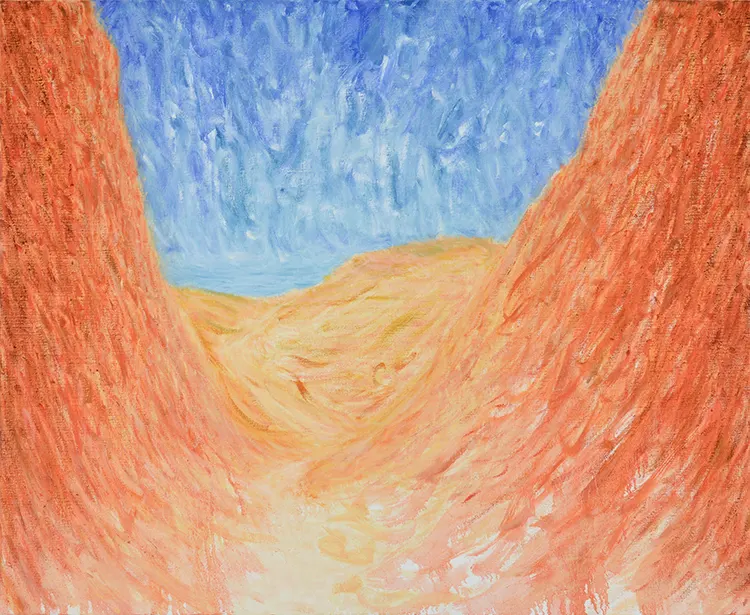
Robert van de Graaf: From Early Inspirations to A Professional Calling
From a tender age, Robert van de Graaf was drawn to the arts, finding solace and expression in the act of painting and drawing. This early passion was nurtured by his family, particularly his English grandmother, an amateur painter and professional pianist, who recognized his potential and supported his artistic development. It was her encouragement and the private lessons she gifted him that laid the foundation for his formal training in art, a period during which he honed his skills and developed a personal style under the mentorship of Dutch artist Erica Meyster. This training, coupled with his architectural studies and experiences in New York City, where he was exposed to the international art scene, played a pivotal role in shaping his artistic journey.
The transition from architecture to art wasn’t instantaneous for van de Graaf. It was a decision marinated over time, catalyzed by his exposure to New York’s vibrant art scene and the realization that his true calling lay in the canvas and paint rather than blueprints and buildings. This epiphany led him to pivot his career entirely towards the arts in 2011, marking the beginning of his professional journey as an artist. His narrative underscores a blend of serendipity and deliberate choice, illustrating how various elements of his life—from his grandmother’s influence to his architectural background—converged to guide him towards his destiny in the art world.

Exploring the Depths: Van de Graaf’s Artistic Vision
Robert van de Graaf’s artistic style is a dynamic amalgamation of gestural abstraction, abstract expressionism, symbolism, and figuration, a testament to his multifaceted inspirations and expansive creative vision. His work delves into the realms of spiritual and religious stories, mythology, and the profound philosophies of life, seeking to unravel the mystical connections that bind the tangible world with the spiritual and the soulful. The artist’s fascination with nature—the sea, forests, mountains—and their inherent tranquility and introspective qualities, serves as a critical element in his creative process. These landscapes are not just backdrops in van de Graaf’s art; they are integral characters that convey the essence of his themes, offering viewers a gateway into the core of existence and inviting them to embark on a journey of emotional and spiritual reflection.
Van de Graaf’s creative methodology involves setting a ‘stage’ for each new series, grounding his inspiration in specific places that resonate with his thematic interests. This approach ensures that his work remains connected to the earthly and the existential, crafting a complex interplay of visual, emotional, and spiritual elements. His pursuit of the divine experience, devoid of religious constraints, underscores a longing for inner freedom and a quest for personal and spiritual growth. This growth, as van de Graaf points out, is not achieved through light-hearted endeavors but through the rigorous challenge of self-improvement and introspection, aiming to question and understand human destiny.

A Nostalgic Masterpiece
Robert van de Graaf’s ‘t Groningerland’ is more than just a piece of art; it’s a cherished relic of his past, a grand oil painting (150 x 240 x 3.0 cm) that he created at the age of 15. This artwork is a cornerstone in van de Graaf’s artistic journey, hanging prominently in his living room, where it stands as a beacon of his youthful exploration into the realms of creativity and expression. For Robert, this painting is a daily source of inspiration and a poignant reminder of the raw, unfiltered joy of artistic creation he experienced in his early years.
Delving into ‘t Groningerland’ offers Robert a reflective journey back to a time of pure artistic freedom, a period when he was engrossed in a natural flow of creativity, unhindered by the constraints or expectations that often accompany professional artistry. This piece encapsulates van de Graaf’s innate painting style, born out of spontaneity and a deep connection to his creative spirit. It symbolizes a moment when art was not just an act of creation but an extension of his very essence, capturing the elusive state of flow that he continually seeks to achieve in his current artistic endeavors.
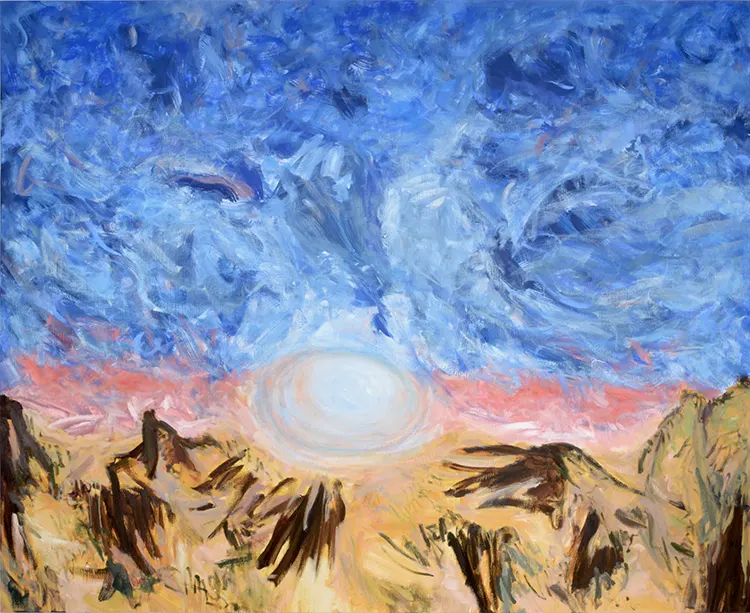
Robert van de Graaf: The Masters Behind the Artist
Robert van de Graaf’s artistic lineage is rich and varied, drawing inspiration from a pantheon of artists who have shaped his perspective and approach to art. Names like Caspar David Friedrich, Anselm Kiefer, Joan Mitchell, and a host of old masters populate his pantheon of influences, each contributing to van de Graaf’s understanding and execution of his craft. Mitchell’s bold, direct, and poetic use of gestural abstraction, Kiefer’s textured landscapes filled with literary and mythological allusions, and Friedrich’s emotional landscapes that touch on the sublime and the spiritual, all echo through van de Graaf’s work, guiding his exploration of themes and techniques.
This eclectic mix of influences not only informs van de Graaf’s stylistic choices but also his thematic exploration. His work, like that of his influences, uses the landscape as a vehicle for expressing complex messages and emotions. For van de Graaf, the act of painting becomes an inquiry into the human condition, a reflection on the spiritual and the sublime, and a meditation on the poetic interplay between the natural world and the human soul. His journey into the realms of watercolor and his innovative use of materials and techniques are a nod to his predecessors’ legacies, a way of honoring their contributions while carving out his own unique path in the art world. Through his work, van de Graaf not only pays homage to these masters but also engages in a dialogue with them, exploring the timeless questions of existence, spirituality, and the human experience.



